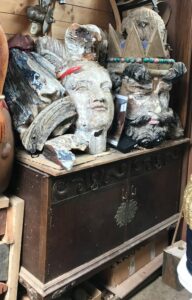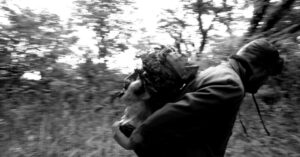Kirsten Norrie draws inspiration from the workshop of Britain’s last ship figurehead carver, and the heads it houses.
*
“Today we have salvaged your form from the sand…” — Pablo Neruda, To a Ship’s Figurehead (Elegy).

Photograph of salvaged figureheads in Andy Peters’ workshop at Waterperry Gardens, by Kirsten Norrie
The marine figurehead was once a severed head. A sacrifice to assuage a difficult sea journey. Stuck on the prow as a bloody offering, it gazed out sightlessly on future time, future circumstance. It is figureheads I have come to see in the making, researching a poetry book titled Ravage*. Latterly, I discover figureheads also held a fascination for the Chilean poet Pablo Neruda, who housed his collection on Isla Negra**. Perhaps in the case of the washed-up ships’ figureheads I have just encountered in a unique Oxfordshire workshop, Neruda’s line could also read: ‘we have salvaged sand from your form(s)…’ as if these great, decapitated heads dredged from the sea had time itself still seeping from their carved lineaments. This is my first thought as I leave Waterperry Gardens, just outside Headington, Oxford, having met with Britain’s last ships’ figurehead carver. I hold this pair of ship-wrecked survivors in my memory. A golden-crowned king and a feather-headed queen. I have seen them and they have seen me.
In ancient times, the ships’ figurehead was also positioned on the prow as part of a predatory disguise. A low-slung vessel gliding through reedy waters — covered with skins, the books say — passed as a hunting animal whose own tongue lolls and eyes are glazed. These were mounted on coracles, canoes, long ships, but their origins are obscure. Only the eye remains out there on contemporary Indian, Greek, Italian fishing boats — an eye to deflect an eye. One is the keen eye of the boat which in turn now seems to have become a severed head, floating in the water. The other is the evil eye of the storm. It is a calm eye which casts its gaze like a net over the perilous conditions of night-fishing. And so, the painted eye of the boat, a residue or stand-in for the presence of an entire figurehead (living or dead), becomes a deflector to the twin evil eye by meeting its gaze. Inevitably Orphic, the boat that carries both the decapitated sacrificial head and fleecy disguise of the animal as a hunting prop now expands. Now, the sea is the fleece and the one-eyed boat, the seeking head. Of all sculpted objects, ships are the ones considered most living. A one-eyed, wooden head on a woolly sea. The ocular: the eye: the ‘I’ of the ship. This is my second thought, on leaving.
I am interested in two things: statuary as mnemonic and ships’ figureheads as uniquely charged, living statuary. In classical Greece a likeness was made of a sailor before a military campaign not from his appearance, but of his exact weight. The statue would be raised in his absence, if he perished at sea. Ships’ figureheads — the erotic, martial, bestial, celebrity, familial — though heavy, are not markers of mass. They personify the spirit of the ship, the living personality of the boat. They are not just a portrait of the boat, but the vessel itself. To encounter a salvaged figurehead, is to see it as if removed from its body: the architecture and sculpture of a smashed or drowned boat.
I am also interested to touch live knowledge, to escape from piles of books and articles. To make the journey to visit Andy Peters at his workshop. It seems to me, that in some senses, Peters is performing a memorial act himself. The knowledge of maritime carving he has accrued over a lifetime will die with him. He doesn’t want an apprentice. He has almost become a living figurehead for this dying craft itself, carrying the weight of the knowledge on his own. Operating out of a formal garden, he is shipbuilding in a manicured forest. Among the old roses and tea lawns, plum and apple orchards, he has a small workshop with perhaps two or three commissions on at once. This is the man who carved the replacement figurehead for the Cutty Sark. His studio is a marine palimpsest: photographs, drawings and plans for figureheads cover the wall behind a workbench where small maquettes stand dustily in the sunlight. Notebooks and drawing pads lie open with future forms sketched out. An array of tools, winches, chains, clamps and ropes are in place: chisels, brushes, saws, sandpaper, glues, paints, varnishes. The air is sweet with wood shavings. In a corner are the two seasoned heads, severed by the sea, or by rot or by neglect. Their massy faces are benign. They’ve been designed by human hands and finished by salt water, sea storms, sand. These are sculptures the ocean completes. This is my third thought, on leaving Waterperry, past the mill where Peters lives. Now, how to glean and apply these impressions, these memories, whilst honouring Peters’ work.
Poetry leads me into strange waters. In my vision, a Shetlandic-Norwegian modernist poet named Kristján Norge carves or salvages figureheads on Eilean a’ Bhàis — a Hebridean Isle of the Dead, convinced he is a demon. In order to forget this impression, he constructs a system to reverse the classical art of memory and this involves ten figureheads each of which embodies ten aspects of his own personality. I am drawing heavily on the work of Frances Yates and Mary Carruthers who pioneered research into classical memory, or mnemonic techniques, in her groundbreaking book The Art of Memory. In it, she outlines the classical creation by Cicero and others of an imaginary memory palace filled with striking images which had agency: imagines agentes. Stunningly beautiful, or strikingly macabre — or both — these images were attached to a tract of information already learned by a speech-maker or rhetor to then be able to recollect and deliver the piece in front of an audience. If you could visualise the imagines agentes, then the memory of the knowledge would be to hand. Imagines agentes, or IA, are stimulae and perhaps mark the beginnings of early computer technology and are a type of early AI. Real and artificial memory were entirely separate in the classical mind: real memory was inherent: organic, and artificial memory was cultivated. You could have a real memory of a dangerous voyage as an ancient ship’s captain, but to recount it formally, your speech would need to be full of mnemonics — memory-stimulating images — and inevitably some of these would reference or paraphrase the sea. This might be done through visual puns, or extreme images: wine-dark images. Orphic images. Strong impressions.
And so, I am left with Norge, my modernist revival, and his attempt to reverse this memorised knowledge of his demonhood, to decipher the imagines agentes in the information, reduce them to a single image and carve or find a figurehead based on this image. In the book, he is his own will and his figurehead is the poet. His illumination, however, is the figurehead of an angel. I am attempting to create these poor marine mannequins for a film to go with the book, out of clay, pâpier-maché, chicken-wire, wood. They are a pitiful sea-court and are taken for a cinematic outing to North Berwick, Scotland, where a tiny sandstone harbour, thought to be the smallest in the UK, is still in use. This is Seacliff Beach and it closes at sunset, says the stile. It is my sanctuary in all weathers and nearly always deserted. Once doused in the sea, the figureheads seem more real, subsequently shedding their sand in glyphs through the car, the garden, the house.

Film still by Kirsten Norrie
Back at home, I have made an angel from incredibly heavy desert driftwood bought at a local aquarium. She has 18th-century carved ‘wings’ I bought as salvage from a wonderful Italian dealer whose antiques shop is accessed through a small door in a barber’s. Geppetto’s workshop meets a Roman tonsor’s mirror. Chained to a hawthorn tree, my angel references the figurehead from an 18th-century wreck which was itself subsequently tied to a wild plum tree, after washing ashore.
Splicing together hours of footage across eight shoots, the first with Anonymous Bosch, the brilliant cinematographer who works on British director, Andrew Kötting’s films, where we first met (me singing to a very gentlemanly Toby Jones in the back of a moving white van) I am getting overdone. My right eye is covered up with a head-scarf for the eye-strain and my left has a stye. I’m doing shifts: up at 4am, back down to sleep at 9am, up again at midday, continuing until 10 or 11pm. My real angel is a painter friend who one day wandered into the bookshop where I used to work. She has all the presence I need. After a stint in a graveyard studded with beehives, somehow the footage finally coheres. Then I realise, as the chained angel just won’t cut well with my living angel, that Norge’s system is broken. I can’t include the angel figurehead, chained to the tree in my garden. The real angel has become the marine totem: illumination has outdone will.
Going outside for a roll-up, I glance at the stone steps, puzzled at the angel’s absence…normally you can see a wing tip over the rosehips. I wander slowly up the steps in the cold and see, to my astonishment, that the angel has been smashed. She has fallen forward, somehow, and is in smithereens. Non-salvageable: her severed head is shattered into hundreds of clay parts, a breast has come off and the chain is driven into her wooden flesh. I think logically, considering the recent storm. But none of the light garden furniture has budged an inch, much less been overturned. There is her chain, still swinging in the wind. She weighs the same as a small washing machine — I can just about shunt her from left to right across flat ground, but can’t carry her on my own. She was the poetic figurehead on the prow of the vessel as a book, illustrated in film. But now, spiritually speaking, she is not necessarily deadweight. This, my own, broken figurehead now carries the weight of recalled illumination.
*
*’Ravage: An Astonishment of Fire’ by MacGillivray was published by Bloodaxe Books in November. Buy a copy here.
**There’s still a book in print, ‘Pablo Neruda, Absence and Presence’ which showcases beautiful photographs of his.
MacGillivray is the matrilineal pen and performance name of poet, musician and artist Kirsten Norrie. The author of four collections of poetry published by Bloodaxe in the UK and Red Hen in the US, she has made nine records, working with producer and musician James Young (Nico, John Cale) and her music features in the soundtracks of three films by avant-garde British director Andrew Kötting. ‘The Demon Tracts’ will be published by Broken Sleep Books in summer 2024, ‘Scottish Lost Boys’ in autumn 2024, and her second novel ‘An American Book of the Dead’ in spring 2025.